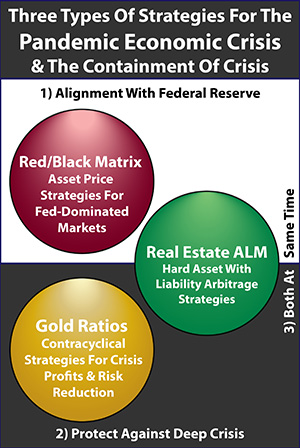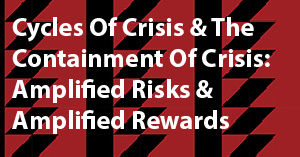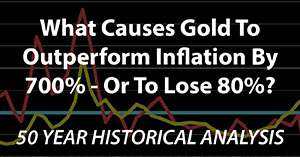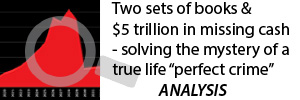Current & Future Supply Side Inflation Shocks
By Daniel R. Amerman, CFA
TweetSurging inflation is currently hitting the United States - but it isn't the kind of inflation that many people believe it is. Inflation can arise from a number of different sources, and money creation is only one of the sources.
The source of this particular bout of inflation is not money creation but supply side shortages. What we are seeing is a fundamental problem that is a separate problem from money creation. Now, that doesn't mean that we won't see inflation that results from money creation, but if we do - we will have two separate fundamental sources of inflation that are multiplicative in combination, with potentially explosive consequences.
There is another particular issue with supply side inflation - despite all their public assurances, the Federal Reserve does not currently have (and never has had) the monetary tool kit to deal with supply driven inflation. The supplies have to physically increase - and the Fed has no ability to do that.
This creates a situation for the 2020s that is more complicated - and more dangerous - than is commonly realized. Current government and political goals call for what is effectively the inducement of supply side inflation over the coming years, through restricting oil production, reducing pipelines, making energy more expensive, making labor more expensive, making cars and homes more expensive, and potentially raising the cost and reducing the supply of anything that requires the emission of carbon dioxide.
At the same time, the fiscal solvency of the U.S. government and current investment prices are effectively based upon ongoing abundant dollar creation by the Federal Reserve (with an equivalent situation in Europe). As we will explore in this analysis, keeping the dollars increasing and the spending up while the physical supplies shrink is like writing out a prescription for a particularly powerful kind of inflation.
This analysis is part of a series of related analyses, which support a book that is in the process of being written. Some key chapters from the book and an overview of the series are linked here.
Shortages Driving Price Increases
The 12 month rate of inflation as measured by the Consumer Price Index (CPI-U) rose to 4.2% in April of 2021, the highest seen in 13 years. On a seasonably adjusted basis prices rose by 0.8% between March and April, this is the equivalent of a 10% annual rate of inflation when annualized (if compounding is taken into account).
A somewhat ominous development that should be getting more attention is that the price of imported goods rose 10.6% between April of 2020 and April of 2021, as the pandemic shutdowns created many kinks in the global supply chain. A nation whose standard of living is based on consuming what it can't produce should keep a close eye on the price of imports, and the increase in import prices accounted for a disproportionate share of the total increase in the CPI.
Gasoline prices rose by 49.6% in 12 months - and this is before the price increases caused by the shutdown of the Colonial Pipeline in May.
The shutdowns associated with the pandemic have created numerous supply kinks when it comes to groceries in particular, with shortages jumping between products even as prices rise. The government reports that the 12 month increase in food prices was only 2.4% - but let me suggest that number is hard to reconcile with most people's actual experience in buying groceries over the last year.
According to the Kelley Blue Book, the average price for a new car reached $40,857 by January of 2021. The reason for the skyrocketing car prices is a shortage in new automobiles that is being driven by a global shortage in the microchips that are critical for producing modern automobiles, along with other supply issues created by the pandemic shutdowns.
The shortage in new cars has spilled over into the used car market, as many buyers who would otherwise be buying new are buying used instead, either because of the shortage in supplies, or the higher prices caused by the shortage in supplies. This has led to an extraordinary 21% increase in average used car prices for the year ending in April of 2021.
An acute shortage of single family homes led to a 12.9% one year increase in home prices in the United States by March of 2021, as measured by the Freddie Mac Home Price Index.
A major contributor to the shortage and the increase in home prices, is the shortages of building materials and labor for building new homes, with the price of softwood lumber climbing 121% in the year ending in April of 2021.
To see so many inflationary price increases in so many categories at the same time is somewhat shocking, and quite different from what was seen in the 2010s. The unifying word is shortages. Pandemic shutdowns created shortages in the food supply chain, the global supply chain and other domestic supply chains. Shortages of computer chips created a shortage of new automobiles that then created a shortage of used automobiles. A shortage of existing single family homes created fast rising prices, even as this was exacerbated by a shortage of building materials helping to create a shortage of new homes.
This is what known as supply driven inflation, where it is shortages of supplies relative to demand that create rising price levels.
A Particularly Difficult Type Of Inflation
Even if the really "smart" thinking at the Fed, U.S. Treasury, IMF and ECB has moved well beyond those basics, one of the cornerstone principles underlying economics is supply and demand. Something that has been long forgotten in the abundance of the modern era is that the two are not equal - a means for creating the supply has to be there first, or the demand is not necessarily all that relevant.
Our modern standard of living is based upon an abundant supply of inexpensive food. The demand has always been there for cheap and plentiful food, but that didn't necessarily matter in earlier years because the agricultural technology wasn't there to create the supply. When that abundant supply wasn't there, then people paid more or they went hungry, as was true for the great majority of human history.
Our modern standard of living is also dependent upon an abundant supply of cheap energy. If the demand is constant or growing while the supply is not because the wells, power plants and the pipelines have shut down, well, that can lead to a real problem at some point. If the plentiful supply of cheap energy isn't there, then it just isn't there, and that is a very tangible and real world physical issue that is quite difficult to overcome with monetary policy, or political talking points, or by having a consensus among the experts and the media.
What beliefs about universal basic income, modern monetary theory and the pandemic policies of the U.S. government and Federal Reserve all have in common is the assumption that a plentiful supply is the natural order of things. Once that assumption is made, then there are no limits with regard to how many people can benefit, and it comes down to making political reallocations of the abundant and ceaselessly flowing stream of wealth, on what is presented to be a fairer and more equitable basis, even as in practice the concentration of wealth flowing to insiders seems to somehow always be increasing as well.
Furthermore - from that perspective - if there is a source of abundant supply that is politically, environmentally or socially objectionable, then it is fine to shut it down. Because the state of abundance is natural, then removing the offensive source of supply would therefore not impact the abundance to be reallocated, as a more or less irrefutable matter of correct thinking political theory.
Demand, Supply & Recessions
The usual impact of a recession or depression is for demand to plummet, with people spending less money, and fewer taxes coming in, even as businesses reduce investments and inventories. This lack of demand then leads to further business closures and rounds of layoffs.
One of the many interesting parts of the workshop earlier in May was going through the long term and bipartisan development of our current new form of monetary creation, that enables far larger government deficit spending, even while permanently federalizing ever more of the U.S. economy, and concentrating ever more of the nation's wealth with Wall Street and major institutional investors. The blue print has been under development for many years, it was the plan, and it wasn't just an emergency response to the Financial Crisis of 2008 or the pandemic of 2020.
What drove the then radical theory that our financial system and investment markets are now effectively based upon, was the idea that the Federal Reserve had far greater powers of money creation than was being taken into account. This would allow the government to provide massive fiscal stimulus in the event of crisis - such as sending out rounds of stimulus checks that showered the population with money - and the Fed would create the money to fund the resulting increase in the national debt. Because the artificial increase in stimulus spending would overcome the natural drop in demand, this would then prevent a depression while shortening the recession.
What was completely lacking from the new theory was physical supply, as in not the supply of money, but the supply of physical goods. An abundant and even excessive supply of physical goods was taken for granted, it was one of the implicit assumptions of the United States in the modern era. So, what would happen if draconian government actions shut down the supply of goods even while unprecedented government spending simultaneously kept demand for those goods high - was not even under consideration.
Keeping the dollars increasing and the spending up while the physical supplies shrink is like writing out a prescription for inflation - and that is exactly what we are seeing. There aren't enough supplies to go around, everyone has money to spend between the stimulus checks, enhanced unemployment checks and rising investment markets, and therefore the prices must rise and quickly.
Transitory Versus Structural
The new establishment buzzword for responding to reports of fast rising inflation is "transitory". The talking points are that what we are seeing are the transitory effects of the high rate of growth that comes from rebooting the economy from its pandemic lows. We are told to expect that this transitory inflation is a temporary development that will disappear by 2022, or 2023 at the latest.
Perhaps.
It will likely take until at least 2022 to get the supply problems worked out in the auto market, and well beyond 2023 to work out the supply problems in the single family home market. Those dates are minimums. As those who remember the 1970s and 1980s will recall, once inflationary cycles and inflationary expectations get going they can take on a life of their own, and economists don't have the tools to deal with those problems anymore than they do fundamental supply-side issues, the current hubris and "expert" consensus notwithstanding.
What was once well understood among economists seems to have been (conveniently) forgotten and wished away, leaving only a misplaced veneer of confidence. It isn't just the cost of fuel and the cost of vehicles that are the issues. It is the increases in prices that eventually follow for everything that is transported by vehicles that use fuel. Because this changes so much of the costs of the standards of living for everyone, the cost of labor must then rise as well - which wraps back around to increasing the cost of producing all supplies, which then leads to yet another round of wage increases. This is simple history, it can be a very difficult cycle to break - and it is also what we have right now, simultaneous supply and labor shortages in a number of industries. Once the genie is truly out of the bottle, what history shows is that putting inflation back into the bottle is not necessarily transitory at all.
However, I think the real issue here is not the transitory but the structural. We have a relatively recent set of political, social and monetary theories that have all been rapidly coalescing and achieving a form of dominance in the United States. Unlimited money creation leads to unlimited government spending that reallocates wealth on the grounds of racial and gender equity while destroying what are viewed as being harmful industries.
What we are seeing a growing structural flaw in real time - and if we're seeing it now, what will we be seeing in five or ten years?
That belief system does not have the supply side under control - it's not even a factor or a consideration. If the political distribution of abundant money is the plan, but increasing or even maintaining the physical supply of the resources to be abundantly distributed is not part of the plan, then we have a built in structural flaw in the plan.
These fundamental, structural dangers go well beyond any transitory issues from the pandemic shutdowns. The plan is for labor to be much more expensive as the minimum wage is forced rapidly upwards, with a particular impact in industries where the pricing is based on low cost labor. The plan is for energy to be more expensive and in shorter supply, for autos to more expensive and in shorter supply, and for anything that relates to carbon emissions in general to be more expensive and in shorter supply. This also very much applies to housing, we're seeing in real time in California what happens when regulatory and environmental barriers create an artificial reduction in supply - the results are shortages that then lead to major price increases and inflation.
The critical, critical part to understand is to see that this isn't just "inflation", nor is it just "money printing" but rather two quite distinct fundamental forces that are each being set in motion for the remainder of the 2020s and beyond. One force is the fantastic rate of increase in the national debt that is being funded not (yet) by money printing, but by using up the limited supply of money that can be created using reserves-based money creation. As we explored at the May workshop and as is also referenced in the analyses linked here and here, this cheap source of money that does not necessarily produce inflation has limits, and when those supply limits are reached then the choice of paths may be between a collapse of the financial system or the replacement of reserves based money creation with pure money creation, running an endless electronic printing press that would indeed quickly lead to high rates of inflation.
Separately, we have a quite different source of inflation that is dominant in the U.S. right now, and that is supply side inflation, inflation that is driven by fewer supplies that then become more expensive. This type of inflation not only degrades the value of money, but it also degrades standards of living. The supplies aren't there for everyone to get the standards of living they want, or expect, or even currently take for granted.
Let's return to the example of the auto market. People who don't like driving older cars are now stuck driving them for longer, that is a reduction in their standard of living. More importantly, the shortages and the 21% increase in used car prices mean that some people simply can't afford to buy used cars, either as their first car or to replace an older car that has broken down. Either way, not having a car at all can be a material reduction in standard of living in our society, this is happening right now for large numbers of people, and the negative effects are disproportionately concentrated among those with lower incomes. Pay more for the cars (inflation), pay more for the gas (inflation), fewer people have cars (reduction in standard of living), and the pain is the worst for the young, the poor - and the retirees.
When the two quite distinct sources of inflation potentially come together in the future, inflation from money creation and inflation from supply shortages creating rising asset prices - then they would reinforce each other, making curing either much more difficult than it would otherwise be. They are also not additive but multiplicative. One fundamental and powerful source of inflation is multiplied times the other fundamental and powerful source of inflation, and the combination destroys the purchasing power of money at a far faster rate than either would do by themselves. There is not only a direct multiplication at any given point in time, but the doubled reinforcement of the core inflationary cycle from both fundamental sources, each acting together to increase the cost of goods which increases the cost of labor which increases the cost of goods.
How the multiplication of multiplications can come to dominate the original simple source multiplications is a key part of the many years of research that came together in writing the Homeowner Wealth series, and are the particular focus of the second book, The Eight Levels Of Homeowner Wealth Multiplication (link here). In studying the national averages for all 395 of the possible 1-10 year homeownership periods between 1975 and 2019, I found that there was a multiplication of general price inflation times housing specific asset inflation more than half of the time - and it is an extremely powerful relationship for homeowners and investors.
The combination of money driven inflation and supply driven inflation would be a triple toxic combination for most people, most of the time. Money driven inflation drives down the purchasing power of dollars, this is multiplied times the power of supply driven inflation, greatly increasing the damage and the speed with which the damage occurs, and the underlying fundamentals of supply shortages then decrease the average standard of living. This is a particularly toxic triple combination for retirees, as they face a doubling of the usual danger from price inflation, even as they are at an inherent disadvantage in competing for scarce resources with those who are still in the workplace and whose incomes are at least partially rising with the rate of inflation. Furthermore, because these are fundamental and cumulative forces at work, they are likely to be persistent over time rather than transitory, with a building level of damage and loss of standard of living.
Not all wealth is being destroyed, however, much of the time it is being redistributed. My research for the Homeowner Wealth Formula books showed that when one creates an asset/liability inflation arbitrage - i.e. buying a home with a mortgage, whether to live in or to rent out - then the fundamental, persistent and cumulative forces flip from being a wealth destroyer to being a persistent and cumulative wealth creator. The national average homeownership results over the decades quite convincingly show that that the higher that either general price inflation or housing asset inflation go, the more real wealth that is created, and that having both at the same times goes from being a nightmare to being an ideal source of wealth multiplication. And the greater the potential supply shortage - the greater the multiplied wealth building that results.
Indeed, that was the intent behind Chapter 10 of the second book, taking the long term potential inflationary consequences of the massive increases in the national debt, and multiplying them times the real price increases that can be result of a long term relative supply shortage for an asset such as homes in desirable locations. The increase in wealth over the long term is extraordinary, as would be the financial contrast between those who have inflation protection over the long term and those who do not.
Fundamentally, inflation is a redistribution of wealth. However, not all inflation is the same, and how the wealth is redistributed can vary depending on what kind of inflation is in play. Between the growth in the national debt, the rate of monetary creation, and the current plans for simultaneously effectively reducing supplies over time in many key components of our standards of living - the 2020s may not be kind for those who are unprepared for inflation.
To be prepared for inflation requires understanding that there is more than one type of inflation. All it takes is one source of inflation coming into play, either inflation resulting from excessive money creation or supply driven inflation, and the 2020s could bring the highest rates of inflation that we have seen in decades. There appears to be a good chance that we will get not just one but both types of inflation at the same time over the coming years, and if that were to happen then the degree of the destruction of the value of the dollar could greatly exceed what would be caused by either single source of inflation by itself. Hopefully this analysis has been helpful in understanding those issues.
Learn more about the free book.
**********************************************
The "Home Wealth Formula For Investors" workshop that will be presented on September 18th & 19th (brochure link here), will be a master class in how to not only understand but to take advantage of the potential intersection between the money creation driven and supply driven sources of inflation over the coming years.
From an investor perspective, the eight levels of the multiplication of homeowner wealth (link here) can provide unique and invaluable insights for evaluating housing risks and opportunities, particularly when they become the inputs for a professional grade asset/liability management and real estate investment model that focuses on both changes in real housing values as well as turning inflation into wealth in a risk controlled manner.
As a starting point, many fear that the red hot housing market of 2021 is in a bubble and is a repeat of the red hot housing market of 2006. The possibility of sudden and sharp losses cannot be discounted, however, as we will explore, the sources of current and future value in 2021 are radically different than they were in 2006.
Among the many differences is the supply driven inflation that is the result of the current severe shortage of single family homes for sale in the U.S. relative to demand. This problem/opportunity is compounded by the supply driven inflation resulting from shortages of lumber and other building materials in combination with labor shortages, when it comes to building the millions of new homes needed to help alleviate the home supply shortage.
However, the biggest factor of all, the "elephant in the living room", is the pervasive distortions of almost every aspect of real estate valuation and returns that are the result of the Federal Reserve's extraordinary market and interest rate interventions. These distortions profoundly impact all eight levels of the multiplication of homeowner wealth, and they simply did not exist in 2006. Funded by an unprecedented degree of money creation, these distortions have created elevated risks in most investment markets, but they have also provided unusual opportunities in other markets, boosting the chances for high future rates of inflation even while essentially subsidizing inflation protection strategies to a degree that would not exist with free markets, as we will be exploring.
















